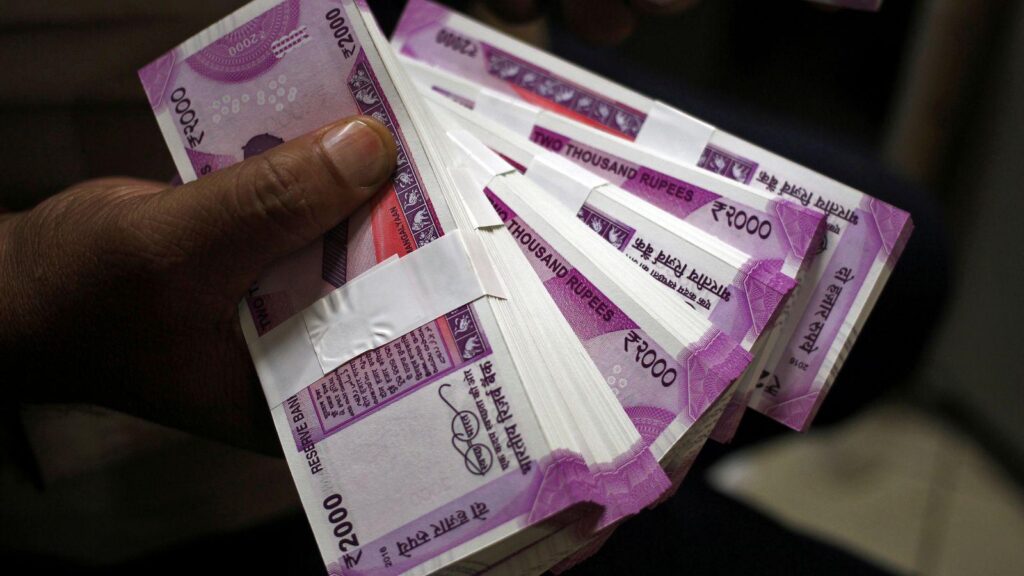The continued fall of the value of the rupee is bad news for commoners, as they will be further burdened by the woes already brought upon them by high inflation.
Indian Rupee (INR) continues to dominate media headlines for all the wrong reasons. Its value against the US dollar continues to fall. On July 5, the exchange rate crossed the Rs. 79 barrier and hit a fresh low of 77.38 and then closing at all-time low of 79.37 against USD.
Notably, globally well known financial services company, Nomura, in its latest report said the rupee could sink to a level of 82 against the dollar by the third quarter of 2022 amid fears of foreign portfolio investors (FPIs) accelerating their exit from emerging economies in the backdrop of Fed aggressively tightening rates to rein in a runaway inflation.
Indian Rupee’s fall from grace is proving to be a nightmare for the central bank – the Reserve Bank of India (RBI). In a bid to alleviate pressure on the rupee’s exchange, RBI announced on July 6 various measure to increase forex inflows to diversify and expand the sources of forex funding so as to mitigate volatility and dampen global spillovers,
However experts don’t see the RBI measures boosting influx of foreign capital into the country and a significant upward impact on the exchange rate is unlikely,
Here, it is in place to mention the Bloomberg data. The market’s assessment of the efficacy of the RBI’s steps was reflected in the rupee’s exchange rate on July 7, with the currency closing just 12 paise higher at 79.18 per dollar.
Without going into the mathematically complex rupee-dollar technicalities, let’s try to understand the falling rupee in the context of common households.
The continued fall of the value of the rupee is bad news for commoners, as they will be further burdened by the woes already brought upon them by high inflation. The falling rupee will further push up inflation as the import prices will increase and commodities will get more expensive. Remarkably, the Reserve Bank of India endorsed that the inflation is hotting up, when it raised the repo rate last week.
Following this increase in repo rate, the banks have started increasing their lending rates. This has translated into costly loans and making equated monthly installments (EMIs) a bigger burden.
A word about the dominance of the US dollar over other currencies merits a mention. The US dollar has been the global benchmark for currencies in all other countries. How weak or strong a particular country’s economy is can be gauged by its exchange rate against the US dollar. Even as there are many strong currencies, the US dollar remains the benchmark against which all currencies are judged, including the INR.
It merits a mention that there are currencies that are even stronger than the U.S. Dollar. According to the web portal siliconindia.com, the Kuwaiti Dinar introduced in 1961 is the highest-valued currency unit in the world. The currency witnessed many ups and downs over the years, especially when it was replaced by the Iraqi Dinar after Iraq invaded Kuwait. The Kuwaiti dinar with the highest banknote of 20 was restored soon after liberation from Iraq. The value of 1 Dinar against Dollar is reported at $3.26 and against rupee it was recorded at Rs 252.36.
At least 10 currencies have been reported to be stronger than the US dollar. But, stronger currency is not a lucrative investment option.
Now, let’s have a look at the journey of rupee against dollar. When India became independent in 1947, a rupee was equivalent to just 1 US dollar. In the mid-sixties, the rupee was devalued and one US dollar was equivalent to 7.5 Indian rupees. After 50 years of independence, the rupee had fallen to about 65 against the US dollar. Today in April 2020, the rupee has plumbed record depths against the US dollar and breached the 77 mark last week on Monday.
If we dig a bit into the dollar dominance scenario, we find a host of economic problems engulfing the economy. Foreign Institutional Investors (FIIs), who have had a very important role in the
Stock markets in India are leaving the country. Flight of FIIs from the Indian markets has put pressure on the value of the rupee against the dollar. The falling rupee can cause further fall in FIIs investment in Indian markets, which can result in a further fall of the rupee.
Weakening of the rupee has been adversely impacting the common man’s financial planning. From essential commodities to the swanky gadgets, the loss of value which the rupee is witnessing has been hurting them in many ways. Since the country is dependent on import of crude oil (almost 80% of the oil is imported), a falling rupee has pushed oil prices to record levels.
Precisely, the falling rupee triggers higher inflation and mounts more economic stress on the common man. Under the circumstances, when INR is losing value against USD, you need to navigate your finances effectively through these rough waters.
Impact of a weak rupee on common people
The appreciation of the US dollar against INR is common man’s irony and a joy for a handful few. The falling rupee makes a serious dent on individual finances. Its depreciation is putting huge pressure on the inflation with essential and other imports getting costlier.
From essential commodities to the ritzy gadgets, the depreciating rupee is hurting all of us in many ways. On one hand, our domestic budgets get squeezed by high inflation and on the other, the continuing fall of the rupee has already made crude oil, fertilizers, medicines and iron ore, which India imports in large quantities, costlier.
For entrepreneurs or a manufacturer who banks on imports in terms of raw material, machinery etc. will face the heat. Their cost of imports will abruptly go up. This means their production costs will increase and will strain their profitability. The increase in cost of production due to falling rupee is passed on to the customers, which translates into price hike in goods.
The falling rupee also brings miseries on the health front. Over a period of time, we have observed a trend developing very fast where people prefer quality treatment of their diseases and bank more upon imported medicines. So, for those undergoing treatment at a hospital and banking upon medicines imported from a different country, the cost of treatment and medication will go up. Otherwise also, the cost of medicines has gone up very high.
A weak rupee influences petrol and diesel prices, as we are dependent on import of crude oil. Fuel has a direct bearing on the cost of transportation. This means the prices of goods transported from one place to another are bound to rise. Ultimately, it is the common people who have to put up with this rising cost of goods as consumers. Fast moving consumer goods like soaps, detergents, deodorants, shampoos too witness price rise every time the dollar gets stronger.
Impact on students studying abroad
Those who have gone abroad to complete an educational course are hit badly whenever the rupee faces a losing streak. The two biggest components of the expenses of such students are tuition fees and the living expenses. Both these would need more Indian rupees when the rupee witnesses a free fall. The problem with these expenses is that they cannot be deferred and usually involve the last date.
According to data, there are about 8 lac students studying abroad. An Indian student, who paid fees at the exchange rate of around Rs.65 per dollar in 2017, might end up paying around almost 80 per dollar this year. Considering that an Indian student spends about $50,000 a year on tuition and hostel facility on average, this could mean an additional spending of over Rs. 8 lac.
Most of the students have taken loans to fund their foreign degree. Education loans are usually in rupees, but as students pay their expenses in a foreign currency, the cost of education and stay has increased. The cost is in a foreign currency while the borrowing is in rupees. So, the students may fall short of funds as the loan would have been taken according to the initial requirements. These additional expenses haven’t been less than a tsunami for the parents as this weakening of rupee was unforeseen by them.
What to do?
Financial experts suggest that parents or guardians of these students should not ignore inflation while planning foreign education for their wards. They should ideally go for hedging currency for education-related expenses by transferring money for expenses every quarter rather than sending it all at once. This way they can average out the price. Even if the expenses are known in advance, they can buy the rupee-US dollar future contract and match the expiry date to the date when money is needed.
Sajjad Bazaz heads Internal Communication & Knowledge Management Department of Jammu & Kashmir Bank Limited.


